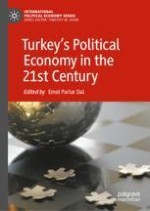2020 | OriginalPaper | Chapter
2. The Political Economy of Turkey’s Economic Miracles and Crisis
Author : Turan Subasat
Published in: Turkey’s Political Economy in the 21st Century
Publisher: Springer International Publishing
Activate our intelligent search to find suitable subject content or patents.
Select sections of text to find matching patents with Artificial Intelligence. powered by
Select sections of text to find additional relevant content using AI-assisted search. powered by
